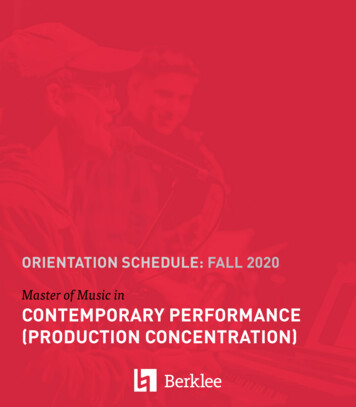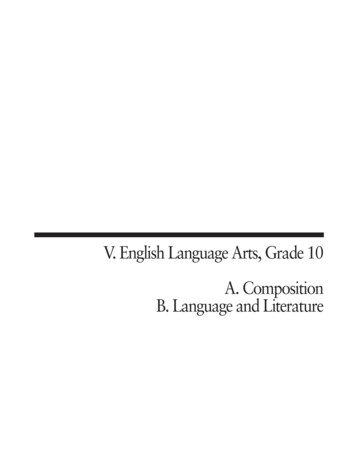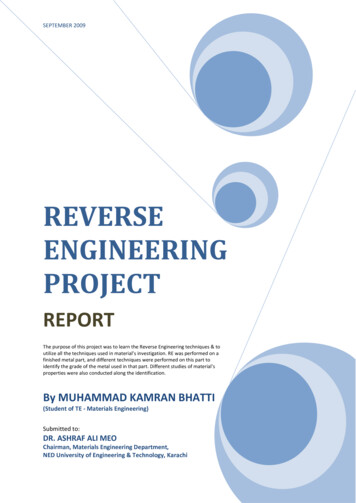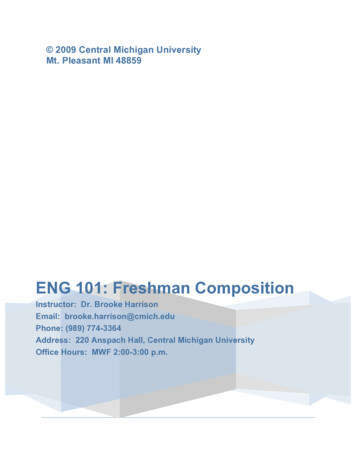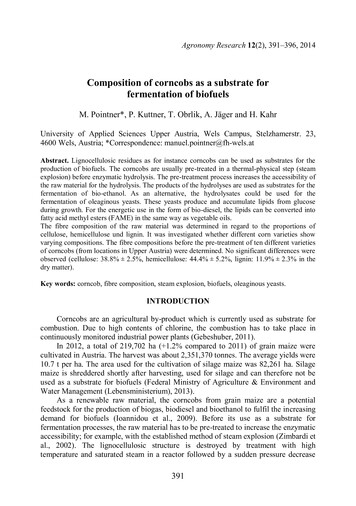
Transcription
Agronomy Research 12(2), 391–396, 2014Composition of corncobs as a substrate forfermentation of biofuelsM. Pointner*, P. Kuttner, T. Obrlik, A. Jäger and H. KahrUniversity of Applied Sciences Upper Austria, Wels Campus, Stelzhamerstr. 23,4600 Wels, Austria; *Correspondence: manuel.pointner@fh-wels.atAbstract. Lignocellulosic residues as for instance corncobs can be used as substrates for theproduction of biofuels. The corncobs are usually pre-treated in a thermal-physical step (steamexplosion) before enzymatic hydrolysis. The pre-treatment process increases the accessibility ofthe raw material for the hydrolysis. The products of the hydrolyses are used as substrates for thefermentation of bio-ethanol. As an alternative, the hydrolysates could be used for thefermentation of oleaginous yeasts. These yeasts produce and accumulate lipids from glucoseduring growth. For the energetic use in the form of bio-diesel, the lipids can be converted intofatty acid methyl esters (FAME) in the same way as vegetable oils.The fibre composition of the raw material was determined in regard to the proportions ofcellulose, hemicellulose und lignin. It was investigated whether different corn varieties showvarying compositions. The fibre compositions before the pre-treatment of ten different varietiesof corncobs (from locations in Upper Austria) were determined. No significant differences wereobserved (cellulose: 38.8% 2.5%, hemicellulose: 44.4% 5.2%, lignin: 11.9% 2.3% in thedry matter).Key words: corncob, fibre composition, steam explosion, biofuels, oleaginous yeasts.INTRODUCTIONCorncobs are an agricultural by-product which is currently used as substrate forcombustion. Due to high contents of chlorine, the combustion has to take place incontinuously monitored industrial power plants (Gebeshuber, 2011).In 2012, a total of 219,702 ha ( 1.2% compared to 2011) of grain maize werecultivated in Austria. The harvest was about 2,351,370 tonnes. The average yields were10.7 t per ha. The area used for the cultivation of silage maize was 82,261 ha. Silagemaize is shreddered shortly after harvesting, used for silage and can therefore not beused as a substrate for biofuels (Federal Ministry of Agriculture & Environment andWater Management (Lebensministerium), 2013).As a renewable raw material, the corncobs from grain maize are a potentialfeedstock for the production of biogas, biodiesel and bioethanol to fulfil the increasingdemand for biofuels (Ioannidou et al., 2009). Before its use as a substrate forfermentation processes, the raw material has to be pre-treated to increase the enzymaticaccessibility; for example, with the established method of steam explosion (Zimbardi etal., 2002). The lignocellulosic structure is destroyed by treatment with hightemperature and saturated steam in a reactor followed by a sudden pressure decrease391
(Menon & Rao, 2012), (Eisenhuber et al., 2013). Per ton of corncobs, 700 kg of monoand oligosaccharides can be obtained by enzymatic hydrolysis. The hydrolysates ofcorncobs are therefore perfectly suited for biodiesel production with oleaginous yeasts.These species of oil-producing yeasts accumulate up to 50% of fat in their dry mass(Kitcha & Cheirsilp, 2011).Corncobs are a lignocellulosic material composed of cellulose, hemicellulose andlignin. These polymeric fibres consist of monomeric molecules. Cellulose is built of C6sugars; hemicellulose mainly of the C5 sugars xylose and arabinose. Lignin consists ofphenolic macromolecules.Cellulose, hemicellulose and lignin are embedded in a complex matrix which isvery resistant to enzymatic degradation (Mosier et al., 2005; Menon & Rao, 2012). Theaim of this paper was to characterize the composition of ten varieties of corncobs asraw material for the fermentative production of bio-fuels. It should be investigatedwhether there are significant differences, especially in regard to the proportions ofcellulose, hemicellulose and lignin.MATERIAL AND METHODSRaw materialCorncobs of ten different varieties of corn (Zea mays) were obtained from theAustrian Agency for Health and Food Safety (AGES) (from variety of trials in UpperAustria), partially air dried at 20 2 C and stored in closed plastic boxes until usage.The varieties investigated for this research are not commercially available and are onlygrown in experimental field trials in Upper Austria. The cobs were chopped up by agarden shredder (Viking GE 260, Kufstein, Austria) to a particle size of 10 mm. Theproportions of fat, protein, starch, ashes, cellulose, hemicellulose, and lignin weredetermined.Dry matter and ash content4 g of the air dried samples were dried until constant weight at 105 C. Toexamine the ash contents ,the crucibles were heated at 550 C for 24 h. The masseswere determined using an analytical scale (Kern 770, Balingen-Frommern,accuracy 0.00001 g).Free sugars20 g of the air-dried corncobs were grinded with a commercial coffee mill(Moulinex, Coffee Grinder, AR 100; Alençon, France). 5 g of the substance weretransferred into a 25 mL reaction tube and filled with HPLC grade water to 25 g. Forthe extraction of soluble substances, the tubes were put into a laboratory shaker at200 rpm for one hour. Saccharides, organic acids, ethanol, and furans were quantifiedusing a high performance liquid chromatography (HPLC). The HPLC system AgilentTechnologies, Santa Clara, 1200 Series with a Varian Metacarb 87 H column (300 *7.8 mm) at 65 C, HsSO4 (c 5 mmol L-1) eluent and an isocratic flow rate of0.8 mL min-1 was used.392
Starch contentThe starch content of the chopped corncobs was detected with the enzymatic testkit ‘Total Starch Assay Kit; α-Amylase / Amyloglucosidase Method’ (Megayzyme,Ireland), according to the AOAC Method 996.11 and AACC Method 76.13 (andimprovements).Protein contentThe protein content was quantified with the nitrogen determination systemDumatherm (Gerhardt, Dumas analytical system, DTM) correspondent to the ASBCAOAC Method 997.09. Protein is detected indirectly by measurement of the totalnitrogen content by combustion. The nitrogen of the sample is burned and reacts toNO3- and is further reduced by elementary copper to form N2. The N2 is measured byconductivity.Fat contentThe fat content was determined quantitatively according to the method AOAC983.23 (Chloroform-Methanol Extraction Method, gravimetric detection).Approximately 10 g of chopped and air dried corncobs were grinded with a coffeemill. 5 g of the grinded substrate was weighed into a round-bottomed flask. Extractionwith chloroform-methanol was done in accordance with AOAC 983.23. The fat contentwas measured via gravimetric analysis after the extraction.Fibre analysisThe contents of cellulose, hemicellulose and lignin were detected gravimetricallyaccording to the modified neutral (Neutral Detergent Fibre NDF) and acid detergentmethod (Acid Detergent Fibre ADF), adapted from the method described by VanSoest et al. (1991).The principle of the detection of cellulose, hemicellulose and lignin is gravimetricanalysis by hot filtration, extraction with organic solvents, and drying, followed bydetermination of the ash contents of the samples.Quantification of Acid Detergent Lignin (ADL) was replaced by directdetermination of cellulose and was conducted by hot liquid extraction with acetic acid,nitric acid, and organic solvents followed by filtration according to the method ofHorwitz & Latimer (2005). For this purpose, hot liquid extraction with an aciddetergent solution according to the method described by Horwitz & Latimer (2005),Neumann & Basler (1976) was performed, followed by filtration with an organicsolvent.The Hemicellulose content was calculated as the difference between NDF(cellulose, hemicellulose and lignin) and ADF. Lignin was detected indirectly bydetermination ADF (lignin and cellulose) and defined as the difference between ADFand cellulose.393
RESULTS AND DISCUSSIONFibre analysisThe contents of cellulose, hemicellulose and lignin of ten different varieties ofcorncobs were determined. For each of them, three repetitions of analyses were carriedout. The following proportions of cellulose, hemicellulose and lignin were detected:cellulose: 38.8% 2.5%; hemicellulose: 44.4% 5.2% and lignin: 11.9% 2.3%).Fig. 1 shows the percentage shares of the polymeric fibres cellulose,hemicellulose and lignin of the different varieties. The individual varieties listed on thex-axis are labelled with numbers and letters. The nomenclation of the corn varieties(origin: experimental field trials) is in accordance with the Austrian Agency for Healthand Food Safety (AGES).portion in % of the dry matter60504030201028A112530271324K2SY0varieties of corncobscellulosehemicelluloseligninFigure 1. Composition of the fibres in different varieties of fresh corncobs.In Fig. 2, the fibre contents (cellulose, hemicellulose and lignin) of ten differentcorncobs are visualized. The fat content was 0.3% 0.02 (mixture of all corncobs).The starch value in the raw material was 0.67% (m/m) 0.12. The protein content was4.26% 0.96. The ash content was 2.88% 0.11 of the dry mass.394
portion in % of the dry celluloselignin0componentsFigure 2. Average shares of fat, starch, protein, ashes, cellulose, hemicellulose, andlignin of the ten different varieties of corncobs tested.CONCLUSIONSAccording to the results of the fibre analyses, there are no significantdifferences (significance level α 0.05) between the corncobs tested. Consequently, itis not necessary to choose one specific plant variety for using as a renewable energysource, namely as a substrate for the fermentation of bio-ethanol or fat by oleaginousyeasts. The polymeric fibre proportions are in accordance with the literature reviewed.The analyses published from Wang et al. indicated contents of cellulose of 40–44%, ofhemicellulose of 31–33%, and of lignin of 16–18% (Wang et al., 2011). Obviously, thehemicellulose content differs from the literature and is significantly higher. For furtherresearch, it might be necessary to compare the results with another established method.Consequently, the contents of the ten different varieties of corncobs examined for thispaper will be additionally compared with acid hydrolysis.ACKNOWLEDGEMENTS. The project ‘Next Generation Biodiesel’ (Project-Code:DAABAA 00565) was financed within the scope of the European Union Program ‘RegionaleWettbewerbsfähigkeit OÖ 2007–2013 (Regio 13)’ from the purse of the European Funds forRegional Development (EFRE) and the Federal State of Upper Austria, Austria.395
REFERENCESEisenhuber, K., Jäger, A., Wimberger, J. & Kahr, H. 2013. Comparison of differentpretreatment methods for straw for lignocellulosic bioethanol production. Agronomyresearch 11, 173–182.Federal Ministry of Agriculture & Environment and Water Management (Lebensministerium).2013. Grüner Bericht 2013, 54, pp. 7–48.Gebeshuber, G. 2011. Energetische Nutzung von Maisspindeln. Wels, Austria:Landwirtschaftskammer Oberösterreich LKOÖ. Retrieved from http://www.suedwindagentur.at/start.asp?termineID 27997Horwitz, W. & Latimer, G.W. (2005). Official Methods of Analysis of AOAC 18,. Gaithersburg,Md. : AOAC International.Ioannidou, O., Zabaniotou, A., Antonakou, E.V., Papazisi, K.M., Lappas, A.A. &Athanassiou, C. 2009. Investigating the potential for energy, fuel, materials and chemicalsproduction from corn residues (cobs and stalks) by non-catalytic and catalytic pyrolysis intwo reactor configurations. Renewable and Sustainable Energy Reviews 13(4), 750–762.Kitcha S. & Cheirsilp, B. 2011. Screening of Oleaginous Yeasts and Optimization for LipidProduction Using Crude Glycerol as a Carbon Source. Energy Procedia 9, 274–282.Menon, V. & Rao, M. 2012. Trends in bioconversion of lignocellulose: Biofuels, platformchemicals & biorefinery concept. Progress in Energy and Combustion Science 38(4),522–550.Mosier, N., Wyman, C., Dale, B., Elander, R., Lee, Y.Y., Holtzapple, M. & Ladisch, M. (2005).Features of promising technologies for pretreatment of lignocellulosic biomass.Bioresource Technology 96(6), 673–686.Neumann, C. & Bassler, R. 1976. VDLUFA Methodenbuch Band III Die chemischeUntersuchung von Futtermitteln 3. Darmstadt.Van Soest, P.J., Robertson, J.B. & Lewis, B.A. 1991. Methods for dietary fiber, neutraldetergent fiber, and nonstarch polysaccharides in relation to animal nutrition. Journal ofDairy Science 74(10), 3583–97.Wang, L., Yang, M., Fan, X., Zhu, X., Xu, T. & Yuan, Q. 2011. An environmentally friendlyand efficient method for xylitol bioconversion with high-temperature-steaming corncobhydrolysate by adapted Candida tropicalis. Process Biochemistry 46(8), 1619–1626.Zimbardi, F., Ricci, E. & Braccio, G. 2002. Technoeconomic study on steam explosionapplication in biomass processing. Applied Biochemistry and Biotechnology, 98–100, 89–99. Retrieved from http://www.ncbi.nlm.nih.gov/pubmed/12018311396
Agronomy Research 12 (2), 391–396, 2014 Composition of corncobs as a substrate for fermentation of biofuels M. Pointner*, P. Kuttner, T. Obrlik, A. Jäger and H. Kahr University of Applied Sciences Upper Austria, Wels Campus, Stelzhamerstr. 23, 4600 Wels, Austr

